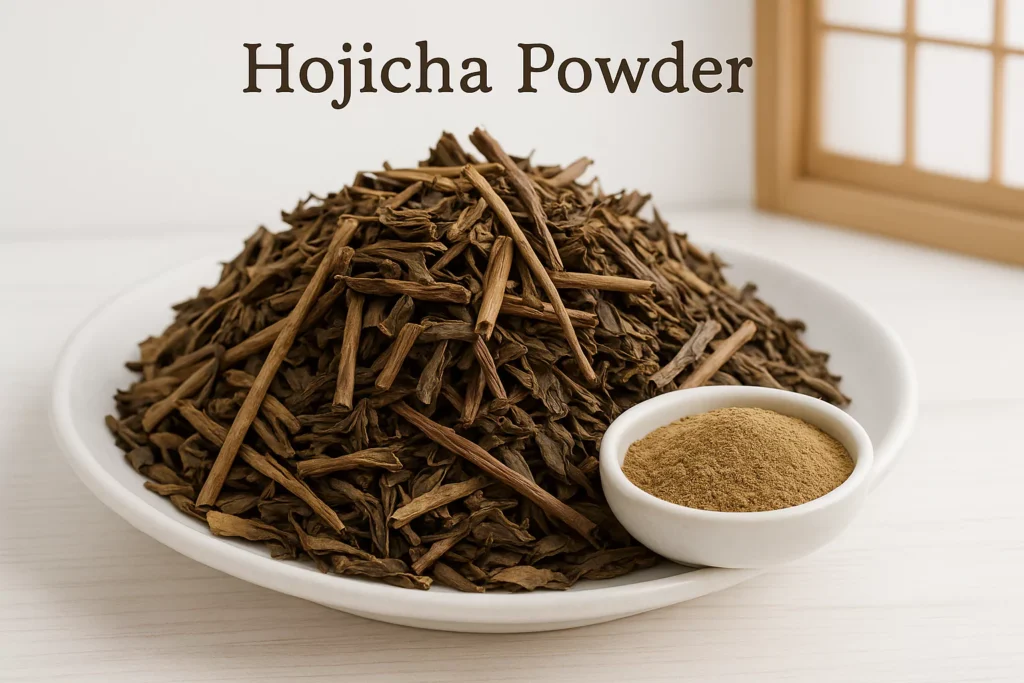Hojicha stands apart in the world of Japanese green teas with its distinctive reddish-brown color and captivating roasted aroma. Unlike its vibrant green counterparts, hojicha undergoes a unique roasting process that transforms both its appearance and flavor profile. Whether you’re new to Japanese teas or a seasoned enthusiast looking to expand your knowledge, this guide will take you through everything you need to know about this comforting, low-caffeine beverage that has been enjoyed in Japan for generations.

What is Hojicha?
Hojicha (ほうじ茶) is a Japanese roasted green tea with a unique smoky flavor and aroma. While it belongs to the green tea family, its appearance might surprise you Hojicha powder has a distinctive reddish-brown color rather than the typical green hue associated with most Japanese teas. This transformation occurs during the roasting process, which fundamentally changes both the tea’s appearance and flavor profile.
The name “hojicha” comes from the Japanese verb “houjiru” (焙じる), which means “to roast.” Unlike other Japanese green teas that are steamed to prevent oxidation, hojicha undergoes an additional step The tea leaves are roasted at high heat in a porcelain vessel, traditionally over charcoal, which enhances their deep, smoky aroma . This roasting process is what gives hojicha its characteristic color, aroma, and taste.

There are two main forms of this Japanese green tea available today: loose-leaf hojicha and hojjicha powder. Loose-leaf is the traditional form, consisting of roasted tea leaves and stems that brew into a light, aromatic tea. Unlike matcha, hojjicha powder is created by finely grinding roasted green tea leaves, giving it a rich, toasty flavor that’s distinctly different from traditional green teas.
The History of Hojicha
While most Japanese teas have centuries-old origins, hojicha is a more recent addition to the tea world. It was first developed in the 1920s in Kyoto, Japan, by tea merchants looking for a way to utilize tea leaves that might otherwise go to waste.
The story goes that a Kyoto tea merchant began roasting leftover tea leaves, stems, and twigs over charcoal as a way to repurpose what would have been discarded. This innovative approach not only created a new type of tea with a unique flavor profile but also proved to be economically beneficial by reducing waste.

Hojjicha quickly gained popularity throughout Japan for several reasons. The roasting process reduced the tea’s caffeine content, making it suitable for evening consumption and for those sensitive to caffeine. Additionally, its warm, comforting flavor appealed to many Japanese consumers, and it soon became a staple in households across the country.
Today, hojjicha has gained international recognition and is enjoyed worldwide for its unique flavor and numerous health benefits. What began as a practical solution to minimize waste has evolved into a beloved tea variety that continues to grow in popularity globally.
Types of Hojicha
Hojiicha comes in several varieties, each with its own distinct characteristics based on the type of tea leaves used and the roasting process. Understanding these differences can help you select the perfect hojicha for your taste preferences.
Loose-Leaf Hojicha Varieties
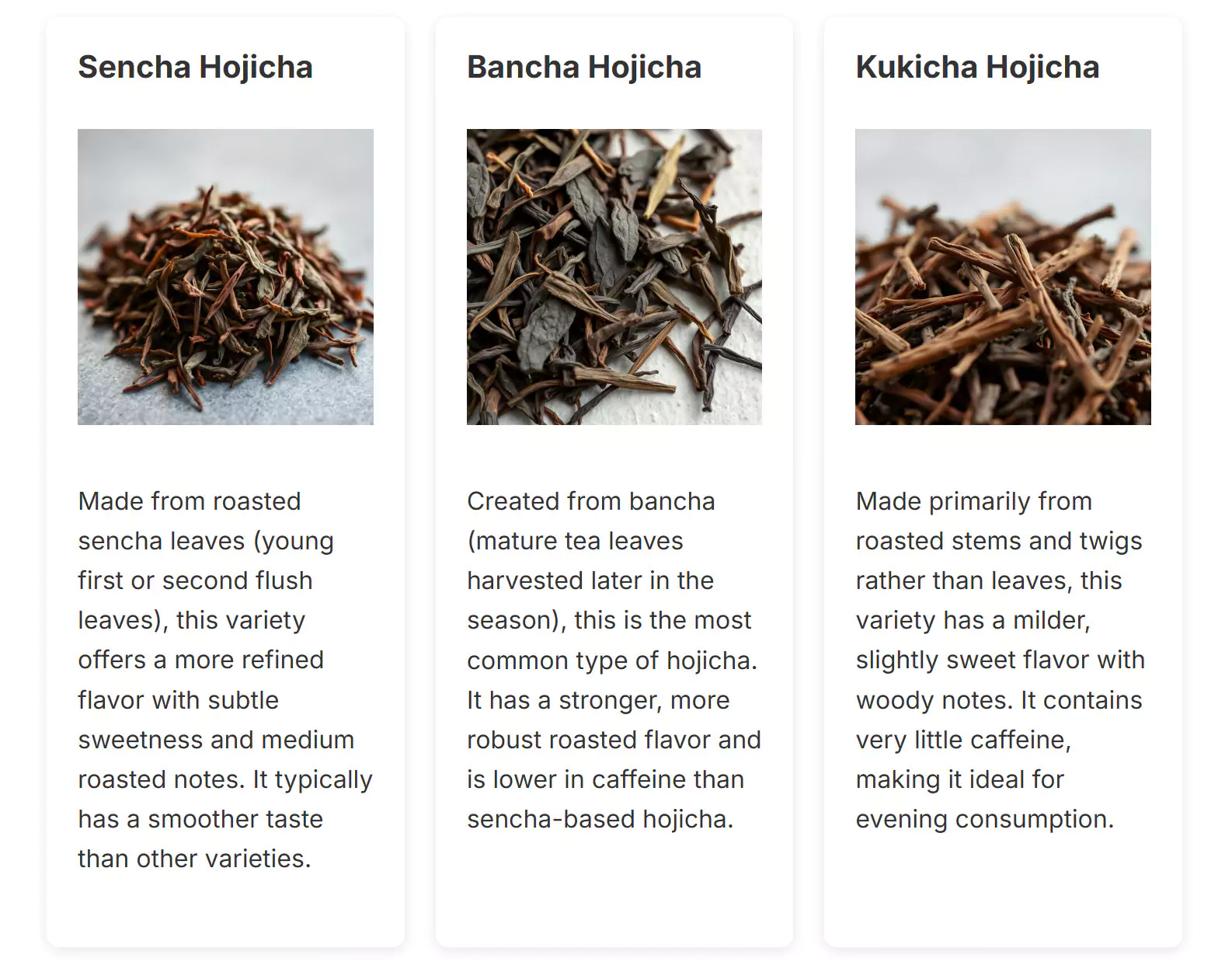
Hojicha Powder
Hojiicha powder is made by grinding roasted tea leaves into a fine powder, similar to matcha but with hojjicha’s distinctive roasted flavor. This versatile form of Japanese green tea can be used in various culinary applications beyond traditional tea preparation.

Culinary Uses for Hojjicha Powder
- Hojjicha lattes and other beverages
- Baking (cookies, cakes, bread)
- Ice cream and other frozen desserts
- Smoothies and protein shakes
- Savory dishes for umami flavor
Roasting Intensity Levels
- Light roast: Subtle roasted flavor with more green tea notes
- Medium roast: Balanced between green tea character and roasted notes
- Dark roast: Strong roasted flavor with caramel and smoky notes
Health Benefits of this Japanese green tea
Japanese green tea offers numerous health benefits, making it not just a delicious beverage but also a healthful addition to your daily routine. While all green teas provide certain health advantages, hojjicha’s unique roasting process creates some distinct benefits.
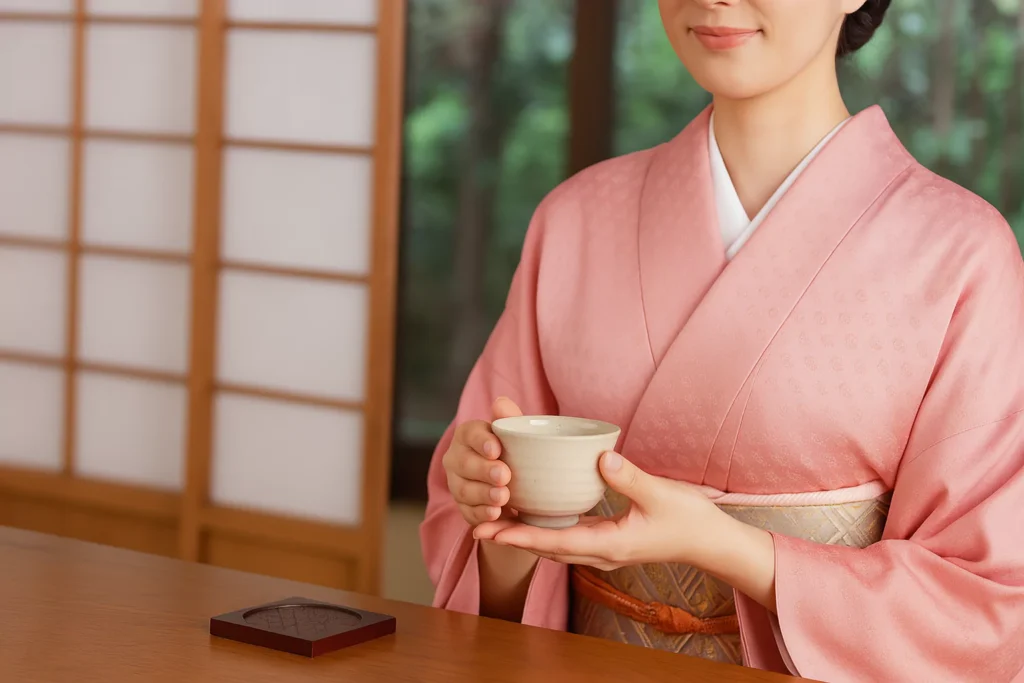
Antioxidant Properties
Like other green teas, hojjicha contains catechins and other polyphenols that act as powerful antioxidants in the body. These compounds help neutralize harmful free radicals, potentially reducing oxidative stress and inflammation. While the roasting process may reduce some catechin content compared to unroasted green tea, hojjicha still retains significant antioxidant properties.
Digestive Benefits
In Japan, hojiicha is traditionally served after meals due to its digestive benefits. The roasting process creates compounds that can help soothe the stomach and aid digestion. Many people find that hojiicha is gentler on the stomach than other teas, making it an excellent choice for those with sensitive digestive systems.
Low Caffeine Content
One of hojiicha’s most notable benefits is its low caffeine content. The roasting process naturally reduces caffeine levels to approximately 7.7mg per cup—significantly less than regular green tea (about 25-30mg) or coffee (95-200mg). This makes hojiicha an excellent option for evening consumption or for those sensitive to caffeine, including children and the elderly.
Relaxation and Stress Reduction
Rich in L-theanine, hojiicha promotes relaxation thanks to this naturally calming amino acid. Combined with its low caffeine content, this makes hojiicha particularly effective for promoting relaxation without causing drowsiness. Many people enjoy hojjicha in the evening as part of their wind-down routine.
Experience the Health Benefits of Premium Hojicha
Our carefully selected this Japanese green tea is roasted to perfection to maximize both flavor and health benefits. Sourced directly from Japanese tea farms with generations of expertise.
Caffeine Content in Hojicha
One of the most frequently asked questions about hojiicha is regarding its caffeine content. The good news for caffeine-sensitive individuals is that Japanese green tea contains significantly less caffeine than most other teas.
Does Hojicha Have Caffeine?
Yes, hojjicha does contain caffeine, but in much smaller amounts than other green teas. During the roasting process, a significant portion of the caffeine is sublimated (converted directly from solid to gas), reducing the overall caffeine content in the final product.
How Much Caffeine is in Hojicha?
On average, hojiicha contains approximately 7.7mg of caffeine per 8oz cup. To put this in perspective:
| Beverage (8oz/240ml) | Caffeine Content | Comparison to Hojicha |
| Hojicha | 5-20mg | – |
| Regular Green Tea | 25-30mg | 3-6x more |
| Matcha | 70-80mg | 9-16x more |
| Black Tea | 40-70mg | 5-14x more |
| Coffee | 95-200mg | 12-40x more |
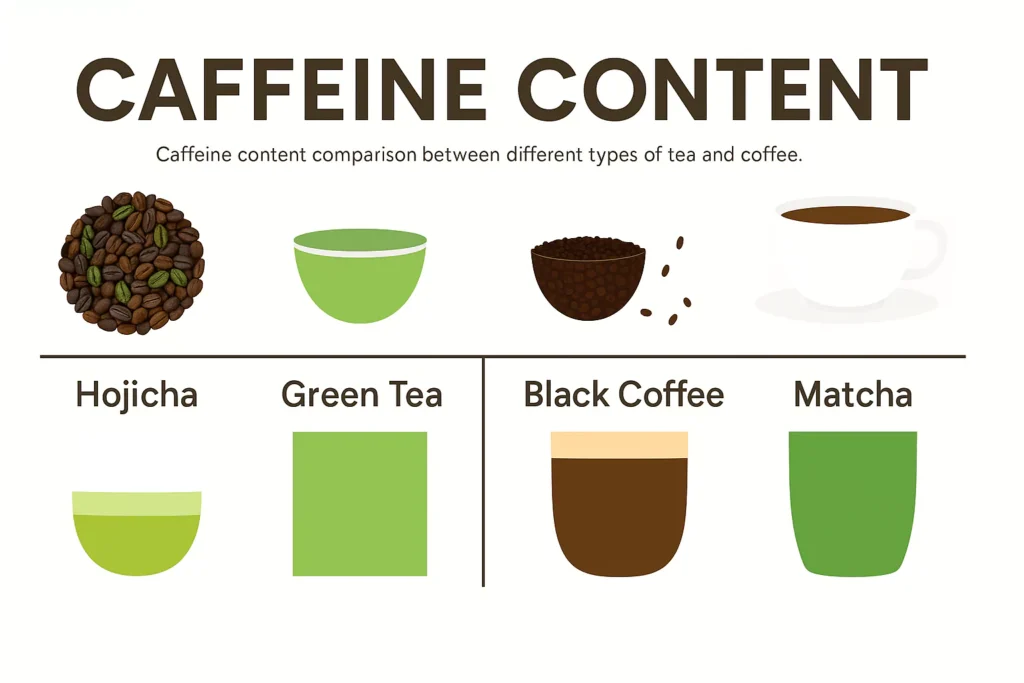
The low caffeine content makes hojiicha an excellent choice for:
- Evening consumption without disrupting sleep
- Children and elderly individuals
- People with caffeine sensitivity
- Those looking to reduce their caffeine intake without giving up tea
What Does Hojicha Taste Like?
This Japanese green tea offers a distinctive flavor profile that sets it apart from other Japanese green teas. If you’re new to this Japanese green tea, understanding its taste characteristics will help you appreciate this unique tea.

Key Flavor Characteristics
Roasted Notes
The most prominent characteristic of hojjicha is its roasted flavor, often described as toasty, nutty, or reminiscent of coffee. This comes directly from the roasting process and varies in intensity depending on the roasting level.
Natural Sweetness
Hojicha has a natural sweetness that emerges during roasting as the sugars in the tea leaves caramelize. This creates subtle notes of caramel or toffee, especially in well-roasted varieties.
Smooth Body
Unlike many green teas that can be astringent or bitter, hojjicha has a remarkably smooth, round mouthfeel with minimal bitterness. This makes it approachable even for those who typically don’t enjoy green tea.
Aroma Profile
The aroma of hojiicha is equally distinctive and plays a significant role in the overall experience. When brewing hojicha, you’ll notice:
- A warm, comforting scent reminiscent of roasted nuts
- Subtle smoky notes from the roasting process
- Hints of caramel or burnt sugar
- A woody, earthy undertone
The flavor of hojicha can vary based on several factors, including the type of tea leaves used (sencha, bancha, or kukicha), the roasting intensity, and the brewing method. Experimenting with different varieties and brewing parameters will help you discover your preferred hojicha experience.
How to Brew the Perfect Cup of Hojicha
Brewing hojjicha properly is key to enjoying its full flavor potential. While hojjicha is generally forgiving compared to other Japanese green teas, following these guidelines will help you achieve the best results.

Basic Hojicha Brewing Method
- Measure the tea leaves: Use 1 tablespoon (about 5g) of loose-leaf hojjicha per 8oz (240ml) of water. For stronger flavor, you can increase to 1.5 tablespoons.
- Heat water to the proper temperature: Bring water to a boil (212°F/100°C), then let it cool very slightly. Unlike other green teas that require lower temperatures, hojjicha benefits from hotter water (195-205°F or 90-96°C).
- Pre-warm your teapot or cup: Pour a small amount of hot water into your teapot or cup, swirl it around, then discard. This helps maintain the brewing temperature.
- Add tea leaves and water: Place the measured tea leaves in your teapot and pour the hot water over them.
- Steep loose-leaf hojicha for 30 seconds to 1 minute. Since it brews quickly, steeping it too long can make the flavor more intense—sometimes even slightly bitter.
- Pour and enjoy: Pour the tea into cups, making sure to empty the teapot completely to ensure consistent flavor.
Cold Brew Hojicha
Cold brewing is a great way to enjoy hojjicha on hot days. It produces a smooth, refreshing flavor with very little bitterness.
To prepare, measure about 1.5 tablespoons (7–8g) of hojicha for every 8 ounces (240ml) of cold water.
Place the tea leaves in a glass jar or pitcher, then pour in cold, filtered water.
Refrigerate: Cover the container and refrigerate for 6-8 hours or overnight.
Strain the brewed tea into a glass over ice and enjoy immediately. You can store cold-brewed hojicha in the refrigerator for up to 3 days for a ready-to-drink refreshment.
Elevate Your Tea Experience
Discover our selection of authentic Japanese teaware specifically designed for brewing hojjicha to perfection. From traditional kyusu teapots to modern brewing systems.
How to Make a Delicious Hojicha Latte
A hojjicha latte combines the rich, roasted flavor of hojjicha with the creamy sweetness of milk, creating a comforting beverage that’s perfect for any time of day. This popular preparation method has gained international popularity and is surprisingly easy to make at home.

Traditional Hojicha Latte Recipe
- Prepare strong hojicha: Brew 2 tablespoons (about 10g) of loose-leaf hojjicha in 4oz (120ml) of hot water (205°F/96°C) for 1 minute. If using hojicha powder, whisk 2 teaspoons (about 4g) with 4oz of hot water until smooth.
- Heat and froth milk: Heat 8oz (240ml) of milk to about 150°F (65°C) and froth using a milk frother, steam wand, or by vigorously whisking.
- To serve, pour the concentrated hojjicha into a mug, then gently add the frothed milk. For a beautiful layered look, hold back the foam with a spoon and spoon it on top at the end.
- Optional sweetener: Add honey, maple syrup, or your preferred sweetener to taste. Hojjicha’s natural sweetness means you’ll need less sweetener than with other tea lattes.
Variations and Tips
Milk Alternatives
- Oat milk: Creates a creamy, slightly sweet latte that complements hojicha’s roasted notes
- Almond milk: Offers a lighter option with nutty undertones
- Coconut milk: Adds tropical sweetness that pairs well with hojjicha’s caramel notes
- Soy milk: Provides good frothability and neutral flavor
Flavor Enhancements
- Vanilla extract: Enhances hojjicha’s natural sweetness
- Cinnamon: Adds warmth and spice
- Cocoa powder: Creates a mocha-like experience
- Caramel: Amplifies the caramelized notes in hojicha
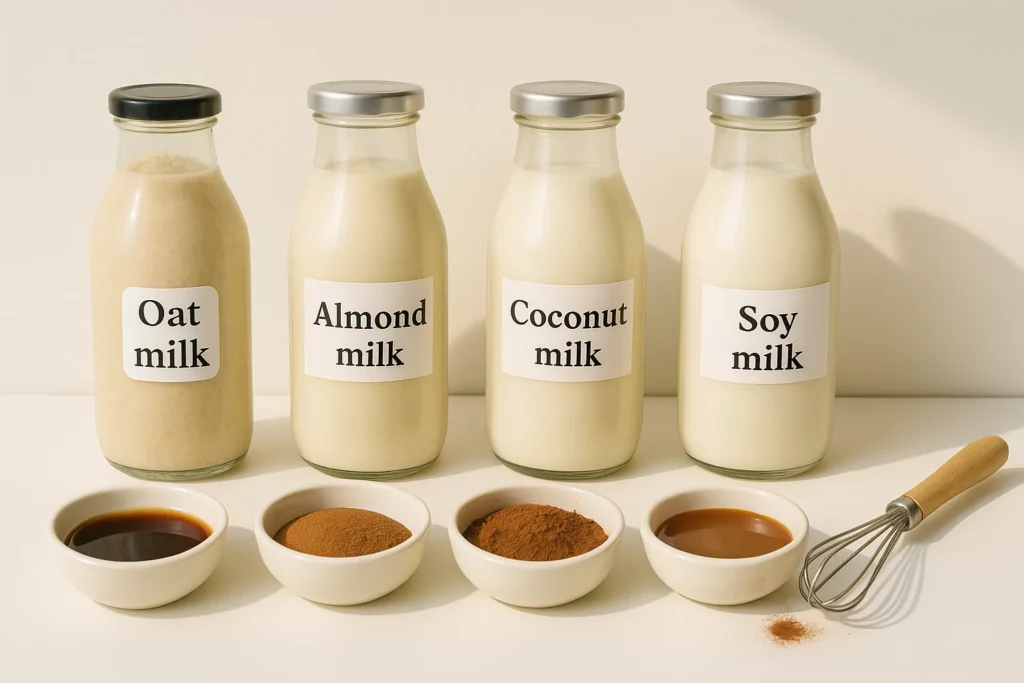
For an iced hojicha latte, simply brew a stronger concentration of hojicha, let it cool, and pour over ice before adding cold milk. This refreshing variation is perfect for summer months.
How to Make a Delicious Hojicha Latte
💡 Looking for a refreshing twist on the classic latte? Try making an iced version at home! Our detailed recipe shows you exactly how to make a smooth and flavorful Iced Hojicha Latte that’s perfect for summer. With its naturally low caffeine and roasted aroma, it’s a chilled treat you’ll want to sip all season.
Frequently Asked Questions About Hojicha
Does hojicha have caffeine?
Yes, Hojicha powder does contain caffeine, but in much smaller amounts than other teas. The roasting process reduces caffeine content to approximately 7.7mg per cup, making it about 70-80% lower in caffeine than regular green tea. This makes Hojicha powder suitable for evening consumption and for those who are sensitive to caffeine.
What’s the difference between hojicha and regular green tea?
The main difference is that Hojicha powder powder undergoes an additional roasting process after the initial processing of the green tea leaves. This roasting transforms the tea’s color from green to reddish-brown, creates a distinctive roasted flavor profile, and significantly reduces caffeine content. Regular green tea (like sencha) retains its green color and has a more vegetal, grassy flavor with higher caffeine levels.
Is hojicha good for weight loss?
Hojjicha contains catechins and other compounds that may support metabolism, though in lower concentrations than unroasted green tea. While it’s not a miracle weight loss solution, hojicha can be a healthy, low-calorie beverage option as part of a balanced diet and active lifestyle. Its low caffeine content also makes it suitable for drinking throughout the day without causing jitters.
Can I drink hojicha at night?
Yes, hojjicha is one of the best teas for evening consumption due to its very low caffeine content. The roasting process reduces caffeine levels significantly, making it unlikely to interfere with sleep for most people. Many Japanese people traditionally enjoy hojjicha in the evening for its relaxing qualities.
How do I store hojicha properly?
Store hojjicha in an airtight container away from light, heat, moisture, and strong odors. For optimal freshness, keep loose-leaf hojicha in the refrigerator, especially in warm or humid climates. Hojicha powder should always be refrigerated after opening. When properly stored, hojicha typically maintains its quality for about one year.
Experience the Unique Pleasure of Hojicha
Hojjicha delivers a one-of-a-kind tea experience, setting itself apart from traditional Japanese green teas. Its gentle roasted taste, low caffeine levels, and healthful properties have helped it earn fans around the globe. Whether you enjoy it as a traditional hot tea, refreshing cold brew, or comforting latte, hojjicha powder provides a versatile and accessible entry point into the world of Japanese teas.

As you explore the world of hojjicha, remember that quality matters. Look for hojjicha powder made from carefully selected tea leaves, properly roasted to bring out the optimal balance of flavors. Whether you’re seeking a caffeine-conscious alternative to coffee, a soothing evening beverage, or simply a new tea experience, hojjicha powder offers something truly special.
If you’re planning a trip or just curious about exploring Japan’s hidden gems, Japan to Visit offers helpful travel tips, destination guides, and cultural insights. It’s a great resource to deepen your understanding of Japanese traditions and places worth visiting.
